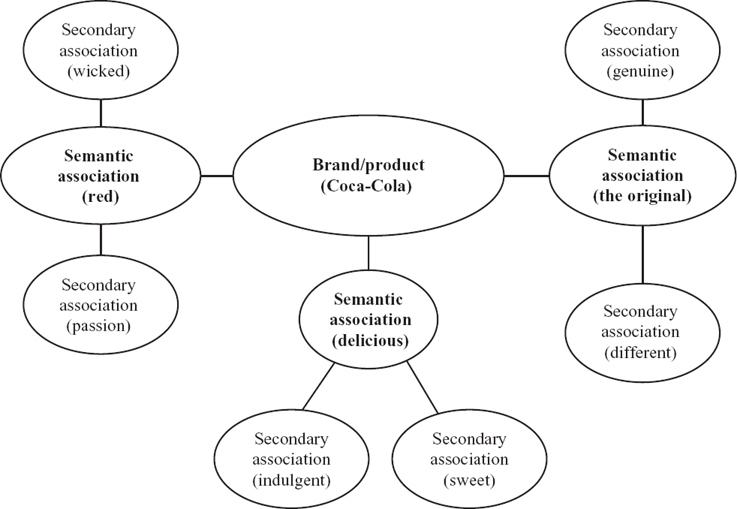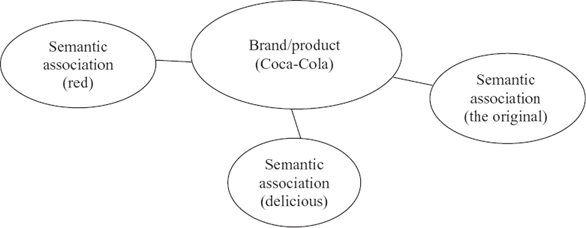19
Associations
The colour red might make you think of red, the colour of passion. Out of this associative network, a kind of staked-out pathway is formed which results in consumers understanding and being attracted to brands and products. By drawing attention to and accentuating certain connections through this network, you can lead people to understand and accept a new product to which they might otherwise find it difficult to relate.
In the disucssion on physiology (Chapter 14) we described how the brain consists of dendrites – the threads that connect its different parts – which, combined, would run several thousand times around the Earth. All those dendrites mean that all the knowledge in your brain is connected in some way. Our entire brain and all our collective knowledge forms a gigantic network of many smaller networks. As soon as you come into contact with a person, a phenomenon or an object, you start thinking about apparently unrelated things. This is because your associative network has been activated.
Figure 19.1 is an example of an associative network for a brand or product. The brand or product is the hub of the network and links a variety of associations that are activated when we think about the brand/product. If you think about Coca-Cola for example, you might get images in your mind of its characteristic red colour, a delicious taste in your mouth (that is, if you like the drink) and that it's the original (which the brand has stressed for a very long time in its marketing communications). These types of associations are called semantic associations, which means that they are directly linked to the brand and determine what the brand means to you. Through the associations red, delicious and the original, you can generate a picture in your mind and a feeling for what the brand stands for.
It's common when working with brands and business opportunities to focus on the brand's semantic associations to find one or more of its core values. In many respects, positioning is about communicating as clear and as consistent a picture of the brand as possible so that everyone will rapidly call to mind a very similar picture of what it offers. In the case of Coca-Cola, it might be about particularly calling to mind the association ‘the original’. In the section on conceptual fluency (see Chapter 17), we saw that in the worst case it can limit the company so that people won't be reminded of the company sufficiently often. But from the point of view of new business creation, there is another problem. By focusing hard on one or more semantic associations, you risk missing the additional and incredible power of people's own associative networks.
As mentioned above and in Chapter 14, all our knowledge is linked together in a gigantic network. The brand's semantic associations are thus linked to other associations, which means that the brand will also have a large number of secondary associations.
Figure 19.2 illustrates associations that you might have to Coca-Cola's semantic associations. The colour red might make you think of wicked (red devil) or red as the colour of passion. Similarly, the semantic association ‘delicious’ has its own associations to indulgence or something sweet, and the semantic association ‘the original’ can associate further to different (‘she's an original – one of a kind’) or genuine.

People won't immediately think of these secondary associations because they are not directly (semantically) linked to the brand, but they do have brand connections to which people can relate if they are made aware of them. Out of this associative network, a type of staked-out pathway is formed that people follow as you stimulate these associations one by one – a pathway that results in people understanding and being attracted to different concepts and to aspects of the brand and products.
By following the path of associations in Figure 19.2, Coca-Cola could, if it wished, develop the concept of love potions and ‘wicked’ products, broaden its position through association to sweets, accentuate aspects such as indulgence when communicating the brand, or create links with phenomena or other products that are different or genuine. A number of possibilities for product development arise from these associations, as well as the creation of new concepts and communications platforms of which people have a ‘pre-programmed’ relationship and understanding.
In experiments from the USA and New Zealand, researchers tested the possibility of launching a number of new, semantically unrelated products (that is, products that people do not immediately relate to the brand and are therefore, in this respect, unexpected for the brand) under a soup brand by accentuating secondary associations to the product category of soup. The researchers managed to get people to accept and buy quite different products such as spaghetti (soup is usually served with more substantial fare – spaghetti), baby food (soup is liquid – doesn't need to be chewed – baby food), frozen vegetables (soup is good for you – so are vegetables), and breakfast cereal (you serve soup in a bowl and eat it with a spoon – as you do with breakfast cereal). In another experiment, Michelin launched sports sandals (tyres – rubber – sandals), Crest toothpaste launched chewing gum (toothpaste – oral hygiene – chewing gum), the biscuit company Keebler launched a fruit drink (Keebler – elves are part of the logo – magic potion) and Heineken launched pretzels (Heineken – green in the logo – pretzels are made of ‘green stuff’/grain/flour).
These experiments are examples of product and concept developments that might appear at first sight to be remote and far-fetched (and which were also received with scepticism when people were asked about the idea), but which worked because the connections in people's own associative networks around the brands and products were accentuated and played upon. This demonstrates the enormous power that is just waiting to be unleashed in the minds of potential customers.
In summary, associative networks can be very helpful in creating new business opportunities by, firstly, functioning as a map for discovering new products, concepts and communications platforms. Associations that are beyond the direct semantic associations to a product category or brand lead to the discovery of possibilities that might otherwise never have been considered. Secondly, the associative network forms a kind of staked-out pathway for people to follow when they come into contact with the new product or concept. By drawing attention to and accentuating the right kinds of connections along this pathway, you can lead people to understand and accept a new product to which they might otherwise find it difficult to relate.


